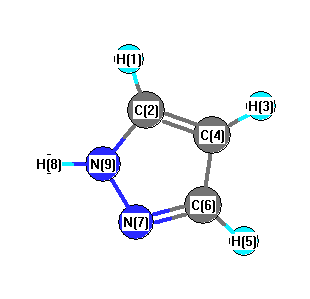.
| squib |
reference |
DOI |
| 1967Kir:1312 |
WH Kirchhoff "The Microwave Spectrum and Dipole Moment of Pyrazole" J. Am. Chem. Soc. 89:6 1312 (1967) |
10.1021/ja00982a006 |
| 1974Nyg/Chr:401 |
L Nygaard, D Christen, JT Nielsen, EJ Pedersen, O Snerling, E Vestergaard, GO Sorensen "J. Mol. Struct. 22 (1974) 401-413 |
10.1016/0022-2860(74)85010-6 |
| 1976Hellwege(II/7) |
Hellwege, KH and AM Hellwege (ed.). Landolt-Bornstein: Group II: Atomic and Molecular Physics Volume 7: Structure Data of Free Polyatomic Molecules. Springer-Verlag. Berlin. 1976. |
|
| 1987JIM/ROU |
Jiminez, P.; Roux, M.V.; Turrion, C., Thermochemical properties of N-heterocyclic compounds. I. Enthalpies of combustion, vapour pressures and enthalpies of sublimation, and enthalpies of formation of pyrazole, imidazole, indazole, and benzimidazole, J. Chem. Thermodyn., 1987, 19, 985-992. [all data] |
10.1016/0021-9614(87)90045-0 |
| 1990Mil:8533 |
KJ Miller "Additivity Methods in Molecular Polarizability" J. Am. Chem. Soc. 1990, 112, 8533-8542 |
10.1021/ja00179a044 |
| 1999Bil/End:157 |
Billes, Endredi, and Jalsovsky. Vibrational spectroscopy of diazoles. J. Mol. Struct. (Theochem) Vol. 465. pgs. 157-172. |
10.1016/S0166-1280(98)00326-1 |
| webbook |
NIST Chemistry Webbook (http://webbook.nist.gov/chemistry) |
10.18434/T4D303 |











